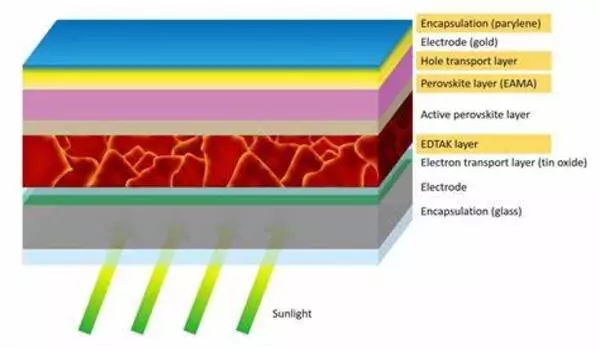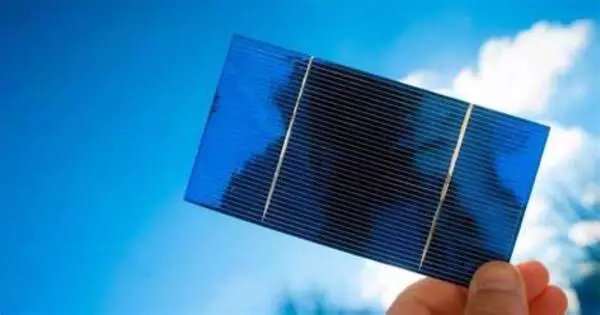Various research institutions throughout the world were working to increase the stability and efficiency of next-generation solar cells. Next-generation solar materials are less expensive and more environmentally friendly to manufacture than existing silicon solar cells, but challenges remain in making the devices durable enough to endure real-world conditions. A new technology developed by an international team of scientists could make it easier to create effective and robust perovskite solar cells, which are named after their peculiar crystalline structure that excels at absorbing visible light.
The researchers, led by Penn State faculty member Nelson Dzade, published their innovative approach for producing more durable perovskite solar cells with a high efficiency of 21.59% conversion of sunlight to electricity in the journal Nature Energy.
According to Dzade, assistant professor of energy and mineral engineering in the John and Willie Leone Family Department of Energy and Mineral Engineering and co-author of the study, perovskites are promising solar technology because the cells can be manufactured at room temperature using less energy than traditional silicon materials, making them more affordable and sustainable to produce. However, the top contenders for these devices, hybrid organic-inorganic metal halides, have organic components that are vulnerable to moisture, oxygen, and heat, and exposure to real-world circumstances can result in rapid performance degradation, according to the scientists.
The beautiful thing about this work is that it shows the fabrication of phase heterojunction solar cells by utilizing two polymorphs of the same material is the way to go. It improves material stability and prevents interconversion between the two phases.
Nelson Dzade
One alternative is to use all-inorganic perovskite materials, such as cesium lead iodide, which has strong electrical properties and is more resistant to environmental influences. This material, on the other hand, is polymorphic, which means it contains many phases with various crystalline structures. Two of the photoactive phases are good for solar cells, but at ambient temperature, they rapidly change to an undesirable non-photoactive phase, which introduces flaws and reduces solar cell efficiency, according to the researchers.
The scientists combined the two photoactive polymorphs of cesium lead iodide to form a phase-heterojunction — which can suppress the transformation to the undesirable phase, the scientists said. Heterojunctions are formed by stacking different semiconductor materials, like layers in a solar cell, with dissimilar optoelectronic properties. These junctions in solar devices can be tailored to help absorb more energy from the sun and convert it into electricity more efficiently.
“The beautiful thing about this work is that it shows the fabrication of phase heterojunction solar cells by utilizing two polymorphs of the same material is the way to go,” Dzade said. “It improves material stability and prevents interconversion between the two phases. The formation of a coherent interface between the two phases allows electrons to flow easily across the device, leading to enhanced power conversion efficiency. That is what we demonstrated in this piece of work.”

The researchers created a device with a power conversion efficiency of 21.59%, which is among the greatest documented for this type of method, as well as remarkable stability. After 200 hours of storage under ambient circumstances, the devices retained more than 90% of their initial efficiency, according to Dzade.
“When scaled from a laboratory to a real-world solar module, our design exhibited a power conversion efficiency of 18.43% for a solar cell area of more than 7 square inches (18.08 centimeters squared),” Dzade said in a press release. “These initial results highlight the potential of our approach for developing ultra-large perovskite solar cell modules and reliably assessing their stability.”
Dzade modeled the structure and electronic properties of the heterojunction at the atomic scale and found that bringing the two photoactive phases together created a stable and coherent interface structure, which promotes efficient charge separation and transfer — desirable properties for achieving high efficiency solar devices.
Dzade’s colleagues at Chonnam University in South Korea created the device’s unique dual deposition approach, depositing one phase with hot air and the other with triple-source thermal evaporation. Adding modest amounts of molecular and organic additives during the deposition process increased the device’s electrical characteristics, efficiency, and stability, according to Sawanta S. Mali, a research professor at Chonnam University in South Korea and the paper’s lead author.
“We believe that the dual deposition technique we developed in this work will have important implications for fabricating highly efficient and stable perovskite solar cells moving forward,” said Nelson Dzade, assistant professor of energy and mineral engineering in the John and Willie Leone Family Department of Energy and Mineral Engineering.
The dual deposition process, according to the researchers, could pave the way for the development of further solar cells based on all inorganic perovskites or other halide perovskite compositions. Future work will include making the existing phase-heterojunction cells more robust in real-world settings and scaling them to the size of standard solar panels, in addition to extending the approach to new compositions, according to the researchers.
“With this approach, we believe it should be possible in the near future to shoot the efficiency of this material past 25%,” Dzade said in a statement. “And once we do that, commercialization becomes very close.”





